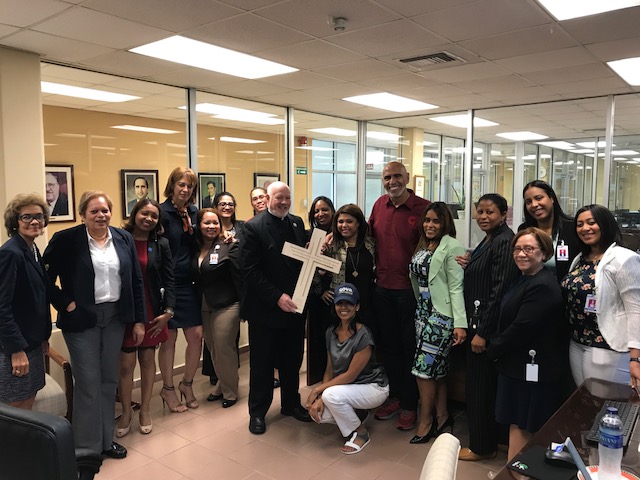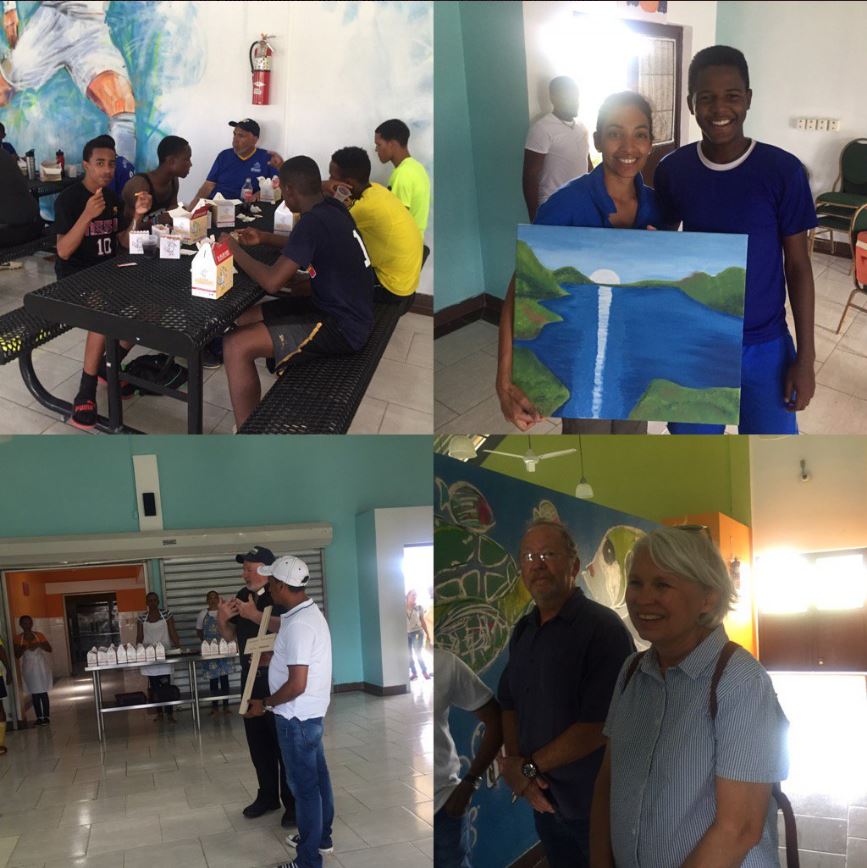
Our Visit to the GOYA Plant in Santo Domingo – Day 2
Our generous partner in feeding hungry New Yorkers, GOYA Foods, invited us to tour its plant in the Dominican Republic. This provided an opportunity to see one of their busy factories that employs about 500 people. In addition to seeing the hard working men and women on the floor of the plant we also met the factory administrators. We also saw the finca (land) where gauyabas (guava) are grown.
I was accompanied on the tour by the director of quality  control, a chemical engineer, charged with complying with regulations of both the Dominican Republic and the United States. He said most of the product from this factory is shipped to the United States. He also proudly spoke to me of the care that is taken to ensure no contamination enters into the products. And he shared with me the sad reality of the added precautions required to protect against intentional poisoning as a terrorist action.
control, a chemical engineer, charged with complying with regulations of both the Dominican Republic and the United States. He said most of the product from this factory is shipped to the United States. He also proudly spoke to me of the care that is taken to ensure no contamination enters into the products. And he shared with me the sad reality of the added precautions required to protect against intentional poisoning as a terrorist action.
You may rightly ask why did I, as the Executive Director of Catholic Charities of the Archdiocese of New York, take the time to visit this GOYA plant in the Dominican Republic. I hinted at one reason: GOYA is a most generous partner. It supports Catholic Charities food programs with hundreds of thousands of pounds of donated food products each year. I was glad to see where they produce some of their products. A second reason is the importance that I believe is often understated of businesses for the work Catholic Charities and those trying to help those who are poor and struggling. Their importance is NOT that they give us donations, although we always need and accept these. It is that they provide decent jobs that support families and quality products and services that people need to live well. I am always interested to understand better the operations of these businesses because of their critical importance to the good of our society.
 After a morning visit to a single factory, I do not claim any expertise but am a little bit more knowledgeable. I saw very hard-working men and women who to my eye took great pride in doing their part to produce a good product as they earned a living for their families. As expected, much of the work is automated; however, not the cracking open and peeling of the coconuts. With incredible skill, 60 men swing machetes and with only a few swings removed the outer shells of the coconuts. An aisle away, 40 women were peeling these de-shelled coconuts in preparation for them to be processed into coconut milk and cream. (I now know that to make coconut cream you leave some of the skin on the coconut. Don’t ask me why; all I know is what I saw and was told.) I saw supervisory staff that seemed to know their workers and a very supportive atmosphere. There was only one lunch/dining room with a kitchen: small, simple and very well kept. It had a large window that looked out into the plant floor. Both staff and executives eat daily in the same dining room together. Talk about longevity – the cook/server/cleaner in the dining room has worked there for 32 years. The two senior executives have worked at the plant respectively for 42 and 45 years. It was a wonderful, informal and delicious lunch that we shared with them.
After a morning visit to a single factory, I do not claim any expertise but am a little bit more knowledgeable. I saw very hard-working men and women who to my eye took great pride in doing their part to produce a good product as they earned a living for their families. As expected, much of the work is automated; however, not the cracking open and peeling of the coconuts. With incredible skill, 60 men swing machetes and with only a few swings removed the outer shells of the coconuts. An aisle away, 40 women were peeling these de-shelled coconuts in preparation for them to be processed into coconut milk and cream. (I now know that to make coconut cream you leave some of the skin on the coconut. Don’t ask me why; all I know is what I saw and was told.) I saw supervisory staff that seemed to know their workers and a very supportive atmosphere. There was only one lunch/dining room with a kitchen: small, simple and very well kept. It had a large window that looked out into the plant floor. Both staff and executives eat daily in the same dining room together. Talk about longevity – the cook/server/cleaner in the dining room has worked there for 32 years. The two senior executives have worked at the plant respectively for 42 and 45 years. It was a wonderful, informal and delicious lunch that we shared with them.
Now for an unexpected, delightful and impromptu part of the visit – probably not too frequent in United States-based plants. I’ve rarely heard this talked about in supervisor-employee relations manuals, but these administrators were quite solicitous for the future prospects of the “solteras” in the office. Solteras means single women in Spanish. So much so that they extended our visit to gather all of them into the “executive office” together for a special blessing. I happily blessed them – and even “las casadas” (married women) also. All in a day’s work!
States-based plants. I’ve rarely heard this talked about in supervisor-employee relations manuals, but these administrators were quite solicitous for the future prospects of the “solteras” in the office. Solteras means single women in Spanish. So much so that they extended our visit to gather all of them into the “executive office” together for a special blessing. I happily blessed them – and even “las casadas” (married women) also. All in a day’s work!
As a concrete sign of our appreciation, I was happy to present this plant with a cross blessed by Pope Francis when he visited immigrants in New York City two years ago. I let them know that on that occasion their CEO, Bob Unanue, a Catholic Charities trustee, read the verse from the Gospel that praises feeding the hungry as feeding Jesus himself. They immediately sought out the most prominent place at the entrance to the plant to hang the cross.
My time at this plant “distracted” me from the current turmoil and divisiveness embroiling the United States about which I have written elsewhere. But in addition to the “distraction,” this time gave me some hope. We were able to experience supervisors, businesses, workers, religious, and charities coming together to draw upon the strengths that each brings to create a better reality than if we remained apart. This is not everything, but it is something. And enough “somethings” in multiple places turn into a big deal.




